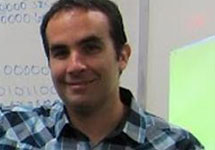
 You can call the Hoffman2 shared research cluster a technical marvel, because it certainly is that. Or you can follow Professor Eleazar Eskin’s lead and call it the people’s cluster. Because it’s here to serve you.
You can call the Hoffman2 shared research cluster a technical marvel, because it certainly is that. Or you can follow Professor Eleazar Eskin’s lead and call it the people’s cluster. Because it’s here to serve you.
Eskin, professor of computer science and human genetics, is a big fan of the Institute for Digital Research and Education’s Hoffman2, the largest and most powerful cluster in the UC system. And he’s thrilled that more and more researchers are taking advantage of its many benefits.
“Groups that had never done high-performance computing before are starting to use it,” Eskin said. “The cluster is for the people, and this is the most exciting thing about it, and this is why it’s having a big impact.”
Eskin’s research focuses on developing methodology for the analysis of the genetic basis of human disease. As a result of recent advances in measuring DNA, genome sequencing has become a primary tool for biomedical science researchers. Consider that the human genome contains about 3 billion pair of DNA molecules, and you’ll understand why this research requires access to the Hoffman2.
“About five years ago, when human genome sequencing became available on this [vast] level, people started doing genome-wide association studies,” Eskin said. “Before gene sequencing machines became available, people used an excel program on their own PCs to analyze data. Each experiment would have 10 data points. With the new technology you have 500,000 data points per individual. It’s a different scale.”
Sequencing — determining the exact order of the base pairs in a segment of DNA — has led to advancements in the understanding of diseases such as obesity, cancer and Alzheimer’s and has become an invaluable tool for researchers across many disciplines. For example, Eskin recently led a UCLA research team that partnered with Israel’s Tel Aviv University to develop software that can identify a person’s ancestry through a saliva sample. He relied on the people’s cluster for his computational needs.
As a computer scientist, Eskin has long appreciated Hoffman2’s importance. But he frequently works with biological science groups that are not as familiar with the cluster. When they ask if they should build their own cluster or buy into the Hoffman2, he doesn’t equivocate.
“I tell them to buy into the Hoffman2,” he said. “They don’t realize the amount of staff time involved in running one of these very complicated computer systems. They think maybe they can do it cheaper on their own. In theory that sounds like it’s going to work but in practice it’s a bad idea. So I’m very vocal to them.”
Dr. Nelson Freimer, Professor of Psychiatry and the Director of the Center for Neurobehavioral Genetics, is another enthusiastic convert to the people’s cluster.
“I’m not a computational person,” Freimer said. “One of the important things about the Hoffman2 is that is has really made high-performance computing available to people who are not computer scientists. [Eskin] is centrally involved, and he’s been very helpful”
Freimer uses DNA sequencing to aid in identifying specific genetic variants implicated in human diseases, including Tourette Syndrome, bipolar disorder and heart disease.
“We generate vast amounts of data from completely sequencing human genomes or pieces of genomes in large numbers of people, and the analysis of that is very computing intensive,” he said.
With help from the Hoffman2, Freimer and his team were able to identify rare DNA genetic variations related to cholesterol, heart disease and diabetes in thousands of people from the country of Finland. The goal of the study was to learn more about genetic risk within a population.
“For biology, the need for this kind of computing didn’t exist until the last couple of years [when genome sequencing became cost-effective],” Freimer said. “Now this is an area of exploding use. The field of genomics and the technology for sequencing both DNA and RNA has gone through great technological leaps.”
Among the new frontiers that might soon become reality, Freimer said, is the possibility of complete sequencing of individual human genomes becoming routine in medicine.
“We can now talk about that possibility,” he added. “Doctors will understand their patients’ vulnerabilities to different diseases, and tailor treatments accordingly.”
Researchers at ULCA’s Lusis laboratory study the factors affecting susceptibility to cardiovascular and metabolic disorders. Postdoctoral fellow Mete Civelek works there, performing human genetics research relating to cardiovascular disease.
A recent study regarding gene expression in adipose, or fat, tissue required looking for statistical associations in DNA variation.
“When I started working on this project I quickly realized I needed a computational cluster,” Civelek said. “I needed a computer that was able to do 20 billion computations. That is when I applied to use the Hoffman2. We collaborated with [Eskin’s lab].”
About 48 hours after the information was fed into the people’s cluster, the calculations were completed.
“It would be practically impossible to do our research without the Hoffman2,” Civelek said.